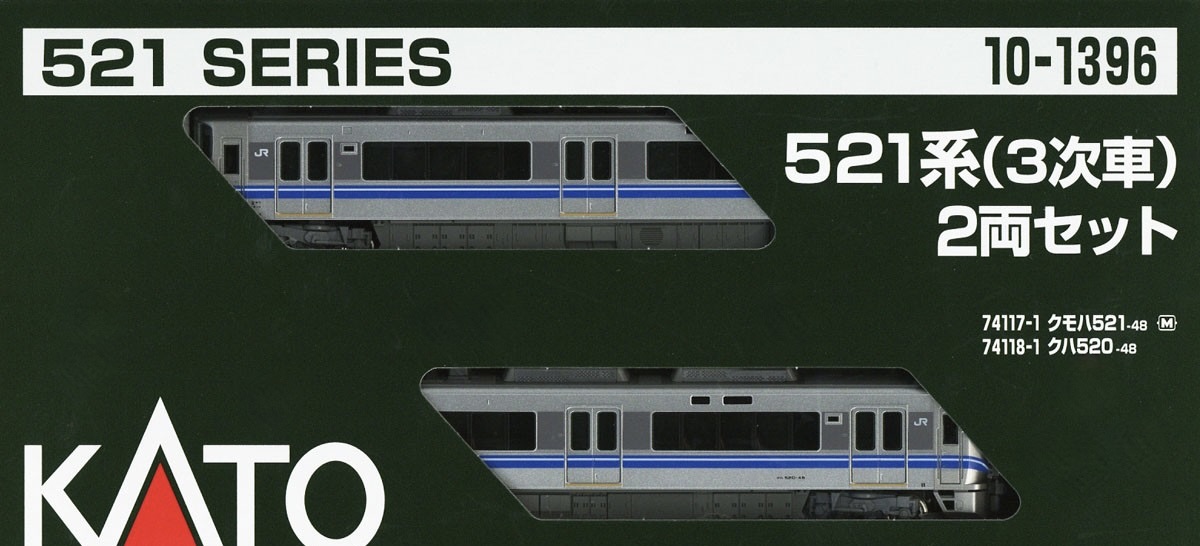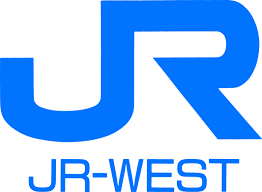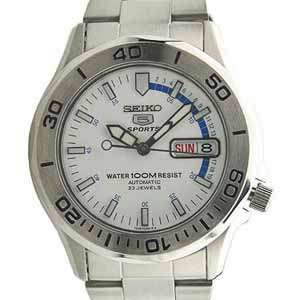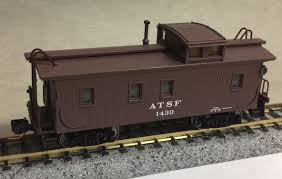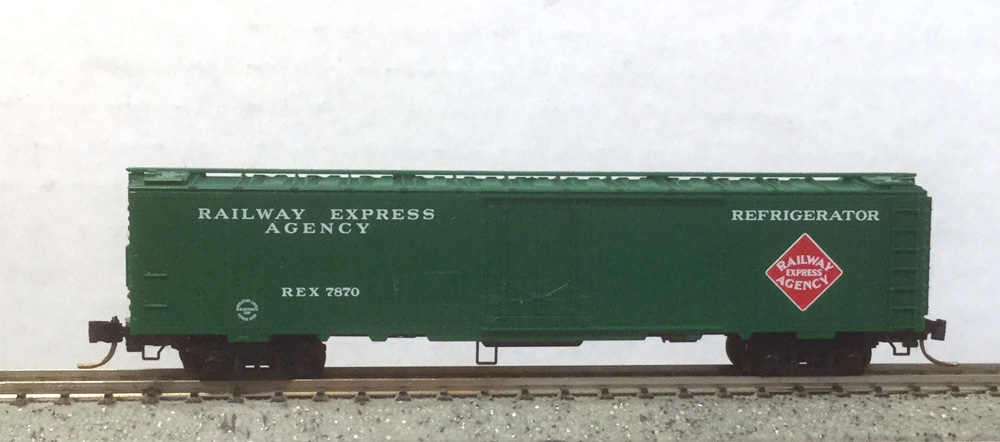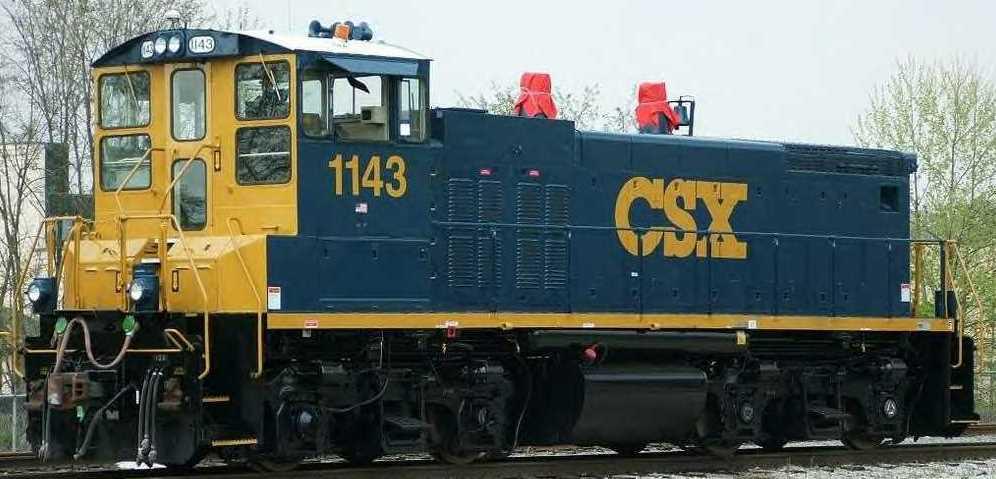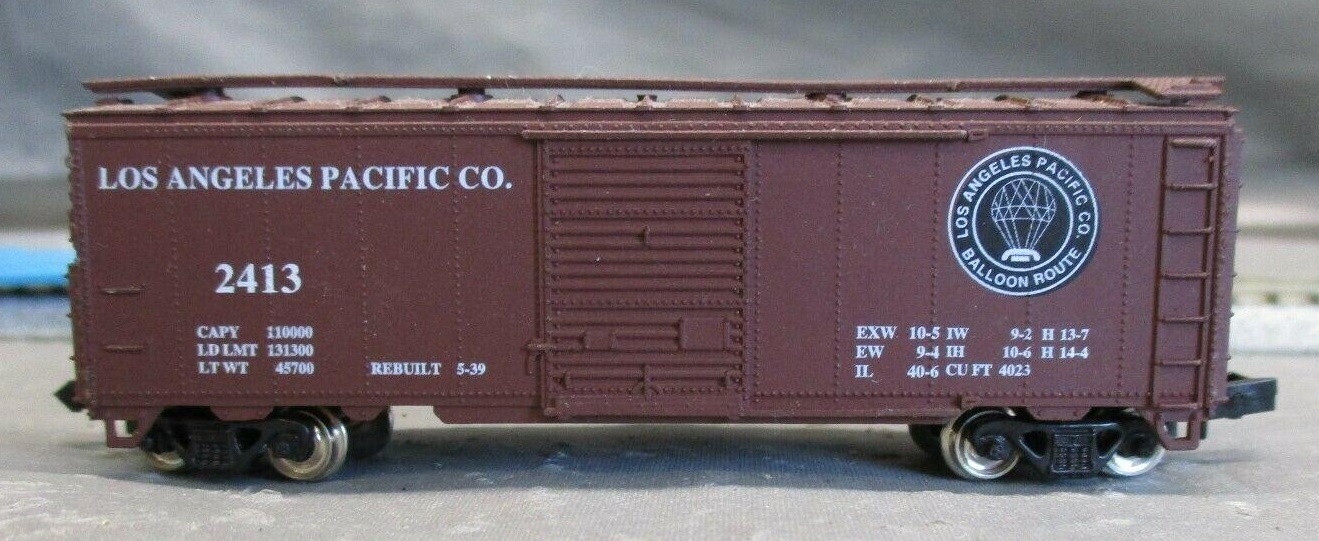Kato - 10-1396 - Locomotive, Electric, Series 521 - Japan Railways West - 2-Pack
| Stock Number | 10-1396 |
| Secondary Stock Number | 101396 |
| Original Retail Price | 10,890¥ |
| Brand | Kato |
| Manufacturer | Kato |
| Body Style | Kato Electric Locomotive Japanese Prototype |
| Prototype | Locomotive, Electric, Series 521 |
| Road or Company Name | Japan Railways West (Details) |
| Reporting Marks | JR |
| Road or Reporting Number | 2-Pack |
| Paint Color(s) | Silver with Blue Stripes |
| Print Color(s) | White & Black |
| Coupler Type | Kato Operating Knuckle |
| Coupler Mount | Body-Mount |
| Wheel Type | Nickel-Silver Plated Metal |
| Wheel Profile | Small Flange (Low Profile) |
| Multipack | Yes |
| Multipack Count | 2 |
| DCC Readiness | Ready |
| Release Date | 2021-10-01 |
| Item Category | Locomotives |
| Model Type | Electric |
| Model Subtype | Passenger |
| Model Variety | Series 521 |
| EAN/JAN/GTIN13 Number | 4949727683829 |
Specific Item Information:
The 521 series is the first new AC/DC suburban vehicle in JR West. In 2006, it appeared for partial DC conversion and constitution improvement of the Hokuriku Main Line. Although the route form changed with the opening of the Hokuriku Shinkansen, it is still the main vehicle for transportation in the suburbs of the Hokuriku area.
Wearing the same blue belt as conventional cars in the Hokuriku area, it features a large number of rooftop equipment unique to AC/DC trains and features with a fall prevention hood. It is possible to reproduce the appearance at the time of rush by connecting 4 cars and 6 cars, and by incorporating the separately sold "headlight dedicated board" (treated as Hobby Center Kato), the intermediate connection leading car aimed at preventing falling from the home The lighting state of the headlights can be reproduced.
The 521 series tertiary type is a group newly built after 2013, and features a driver's cab with a shock absorbing structure and a light arrangement with a different grain. All trains belong to the Kanazawa Car Maintenance Center, and are operated in a 6-car train with a maximum of 3 trains in common with the conventional trains between Tsuruga and Kanazawa on the Hokuriku Main Line. When the Hokuriku Shinkansen opened in 2015, two trains were transferred to IR Ishikawa Railway, and Ainokaze Toyama Railway also has new cars with the same appearance.
Wearing the same blue belt as conventional cars in the Hokuriku area, it features a large number of rooftop equipment unique to AC/DC trains and features with a fall prevention hood. It is possible to reproduce the appearance at the time of rush by connecting 4 cars and 6 cars, and by incorporating the separately sold "headlight dedicated board" (treated as Hobby Center Kato), the intermediate connection leading car aimed at preventing falling from the home The lighting state of the headlights can be reproduced.
The 521 series tertiary type is a group newly built after 2013, and features a driver's cab with a shock absorbing structure and a light arrangement with a different grain. All trains belong to the Kanazawa Car Maintenance Center, and are operated in a 6-car train with a maximum of 3 trains in common with the conventional trains between Tsuruga and Kanazawa on the Hokuriku Main Line. When the Hokuriku Shinkansen opened in 2015, two trains were transferred to IR Ishikawa Railway, and Ainokaze Toyama Railway also has new cars with the same appearance.
Road Name History:
JR-West was incorporated as a business corporation (kabushiki kaisha) on April 1, 1987 as part of the breakup of government-owned Japanese National Railways (JNR). Initially, it was a wholly owned subsidiary of the JNR Settlement Corporation (JNRSC), a special company created to hold the assets of the former JNR while they were shuffled among the new JR companies.
For the first four years of its existence, JR-West leased its highest-revenue line, the Sanyō Shinkansen, from the separate Shinkansen Holding Corporation. JR-West purchased the line in October 1991 at a cost of 974.1 billion JPY (about US$7.2 billion) in long-term payable debt.
JNRSC sold 68.3% of JR-West in an initial public offering on the Tokyo Stock Exchange in October 1996. After JNRSC was dissolved in October 1998, its shares of JR-West were transferred to the government-owned Japan Railway Construction Public Corporation (JRCC), which merged into the Japan Railway Construction, Transport and Technology Agency (JRTT) as part of a bureaucratic reform package in October 2003. JRTT offered all of its shares in JR-West to the public in an international IPO in 2004, ending the era of government ownership of JR-West. JR-West is now listed on the Tokyo Stock Exchange, Nagoya Stock Exchange, Osaka Securities Exchange and the Fukuoka Stock Exchange.
From Wikipedia
For the first four years of its existence, JR-West leased its highest-revenue line, the Sanyō Shinkansen, from the separate Shinkansen Holding Corporation. JR-West purchased the line in October 1991 at a cost of 974.1 billion JPY (about US$7.2 billion) in long-term payable debt.
JNRSC sold 68.3% of JR-West in an initial public offering on the Tokyo Stock Exchange in October 1996. After JNRSC was dissolved in October 1998, its shares of JR-West were transferred to the government-owned Japan Railway Construction Public Corporation (JRCC), which merged into the Japan Railway Construction, Transport and Technology Agency (JRTT) as part of a bureaucratic reform package in October 2003. JRTT offered all of its shares in JR-West to the public in an international IPO in 2004, ending the era of government ownership of JR-West. JR-West is now listed on the Tokyo Stock Exchange, Nagoya Stock Exchange, Osaka Securities Exchange and the Fukuoka Stock Exchange.
From Wikipedia
Brand/Importer Information:
Kato Precision Railroad Models (関水金属株式会社 Sekisui Kinzoku Kabushikigaisha) is a Japanese manufacturer of model railroad equipment in N and HO scales. The Tokyo-based company manufactures models based on Japanese prototypes (such as the Shinkansen bullet train) for the Japanese market, North American prototypes for the North American market and European high-speed trains for European market.
The Kato (pronounced kah-toe) model railroad companies were founded by Yuji Kato, father of current president Hiroshi Kato, of the parent company Sekisui Kinzoku Co., Ltd.
The design and distribution of models for the North American market are handled by their U.S. subsidiary, Kato USA, located in Schaumburg, Illinois.
The design of special models for the European market is handled for some of them by their partner, Lemke, whereas the general distribution of Kato products in Europe is handled by NOCH; both companies are located in Germany.
As a result, some Kato European models are sold as Kato Lemke and others as Kato (alone).
The Kato (pronounced kah-toe) model railroad companies were founded by Yuji Kato, father of current president Hiroshi Kato, of the parent company Sekisui Kinzoku Co., Ltd.
The design and distribution of models for the North American market are handled by their U.S. subsidiary, Kato USA, located in Schaumburg, Illinois.
The design of special models for the European market is handled for some of them by their partner, Lemke, whereas the general distribution of Kato products in Europe is handled by NOCH; both companies are located in Germany.
As a result, some Kato European models are sold as Kato Lemke and others as Kato (alone).
Item created by: CNW400
on 2022-01-31 10:07:48
If you see errors or missing data in this entry, please feel free to log in and edit it. Anyone with a Gmail account can log in instantly.
If you see errors or missing data in this entry, please feel free to log in and edit it. Anyone with a Gmail account can log in instantly.


